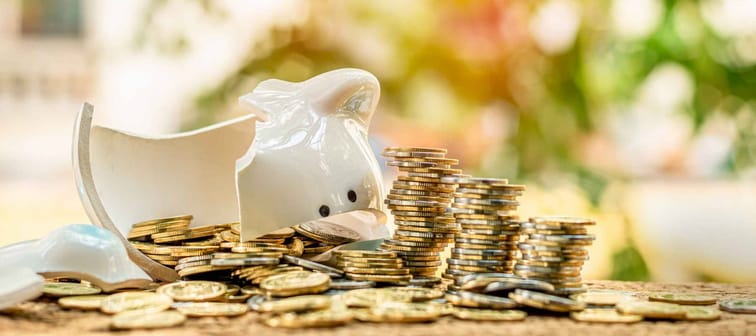How do RRSPs work?

First off, if you’ve got a healthy RRSP, congratulations on being ahead of the game; 39% of Canadians don’t have any retirement savings at all. Not everyone who has an RRSP has a firm grasp on how they work, though, so let’s quickly cover the basics.
The money you put into an RRSP is tax-deferred. You get to deduct your contributions from your taxable income for the year — reducing the amount you pay or netting you a refund at tax time — and you won’t be taxed on any growth in the account.
You only pay when you withdraw the money, ideally when you’re retired and in a much lower income-tax bracket.
It’s a smart way to build your wealth, but there is a limit to how much you can contribute.
Each year, you’re allowed to contribute up to 18% of your pretax income (though if you make a lot of money, you can hit the cap for the year, which is $27,230 for 2020.) Any unused contribution room rolls over, increasing your limit next year so you can make up for lost time.
Unexpected vet bills don’t have to break the bank
Spot Pet Insurance offers coverage for treatment of accidents, illnesses, prescriptions drugs, emergency care and more.
Plus, their preventative care plan covers things like routine check-ups, microchip implantation, and vaccinations, if you want to give your pet the all-star treatment while you protect your bank account.
Get A QuoteWithdrawing after retirement

This is how the system is supposed to go.
You can stop contributing to your RRSP and start using it whenever you decide to retire, but you’ll have to make the switch by the end of the year you turn 71. You have three options with the money:
-
Take a lump sum. Yes, you can take the money and run, but you’ll suffer a tax two-fer. Your sack of cash will come with an immediate “withholding tax” — more on that later — and the entire lump sum will be counted as income at tax time, spiking the amount you pay.
-
Purchase an annuity. Similar to a pension, annuities will provide steady payouts over an extended period of time. You can get one for a fixed term or for the rest of your life.
-
Convert to a Registered Retirement Income Fund. An RRIF looks a lot like an RRSP, but you won’t be able to add more money to it. Instead, you’ll have to withdraw a minimum portion of your savings each year while the rest continues to grow. Unless you cash out more than the minimum, there’s no withholding tax.
The best way to minimize taxes after retirement is to use an annuity or RRIF to withdraw the funds slowly, so you don’t accidentally trip over into a tax bracket normally reserved for high rollers.
Withdrawing before retirement

If disaster strikes and you can’t wait until the account matures, you are able to make withdrawals from an RRSP at any time. But before you commit to the idea, consider what it will cost:
-
You’ll get taxed. Your withdrawals will contribute toward your annual income tax, and if you’re still making good money right now, you’ll suffer a bigger tax burden.
-
You’ll lose compounding interest. The longer your money stays in the account, the more time it has to grow in safe, tax-sheltered conditions.
-
You’ll lose contribution room. No backsies on this one. When you take money out of your RRSP, you don’t get the contribution room back.
-
You’ll get taxed (again). If paying more at tax time wasn’t enough, RRSP withdrawals also come with an instantaneous “withholding tax.”
Canada’s top credit cards—find your perfect match!
Maximize rewards, save on interest, or earn cash back. Compare the best credit cards in Canada and pick the one that works for you!
Find Your Card NowWhat is withholding tax?

When you withdraw money from an RRSP before retirement, your financial institution immediately “withholds” a percentage for income tax purposes and sends it straight to the government. It’s just like when your employer withholds a portion of your wages on each paycheque.
The rate depends on which province you live in and how much you take out. For most Canadian residents, the withholding tax rates are:
-
10%, up to $5,000.
-
20%, from $5,001 to $15,000.
-
30%, from $15,001 and higher.
The Québécois have lower tax rates but also have to pay a provincial sales tax.
-
5%, up to $5,000.
-
10%, from $5,001 to $15,000.
-
15% from $15,001 and higher.
Non-residents of Canada pay a flat withholding tax of 25%.
That definitely stings, but we’re not done yet. The amount withheld probably won’t cover your full tax obligations, once your RRSP withdrawal gets added to your income for the year. That means you’ll be on the hook for even more come tax time.
If you want to see where you’ll land, the federal income tax scheme for 2020 looks like this:
-
15% on the first $48,535 of taxable income, plus
-
20.5% on the portion of taxable income over $48,535 up to $97,069, plus
-
26% on the portion of taxable income over $97,069 up to $150,472, plus
-
29% on the portion of taxable income over $150,473 up to $214,368, plus
-
33% of taxable income over $214,368.
Provincial taxes vary, so you’d want to check this handy chart from the Canada Revenue Agency.
How to avoid paying taxes

OK, so all of that sounds terrible; is there a way around it?
Well, you can avoid paying any tax whatsoever so long as you use your RRSP money on one of two major investments — and only if you repay the money years down the line.
First-time homebuyers can take advantage of the federal Home Buyers Plan. You can withdraw up to $35,000 ($70,000 for couples) to put toward the down payment on your new homestead.
The Canada Revenue Agency considers you a first-time buyer so long as you haven’t occupied a home that you or your current partner owned in the last four years.
The money you take out isn’t added to your income, and there’s no withholding tax. Repayment starts two years after the money is withdrawn, and you have 15 years to pay the full balance back into the RRSP. Any missed payments get taxed as income.
Alternatively, the Lifelong Learning Plan allows you to use money from your RRSP on education or training, either for you or your spouse.
The program needs to occupy at least 10 hours of your time per week, last at least three months and take place at a “designated” institution, like a university.
You can withdraw up to $10,000 per year, but the lifetime maximum is $20,000. Again, this money isn’t taxed — so long as it’s repaid within a 10-year period, starting 5 years after the money is withdrawn.
Other places to pull from

If you’re unable to take advantage of either program — sadly, there’s no such thing as a federal Roof Repair Plan — you may want to look into other sources of fast cash.
Personal loans and lines of credit are especially cheap right now and can be used on all kinds of expenses. To get the best interest rate, make sure your credit score is in good shape and use an online service like LoanConnect to compare multiple lenders.
Then, once you’ve dealt with the current crisis, be sure to create an emergency fund so you don’t need to consider plundering your RRSP again.
Financial experts recommend stashing away money equal to at least three to six months of your regular expenses. Either a Tax Free Savings Account (TFSA) or high-interest savings account will allow your cash to grow while you’re not using it — and won’t expose you to penalties when you need those funds the most.
Smart investing starts here
Get 100 free online equity trades with promo code EDGE100 when you open a CIBC Investor’s Edge account by Sept. 30, 2025. Click here to unlock 100 free trades and take control of your investments. Get started today.









